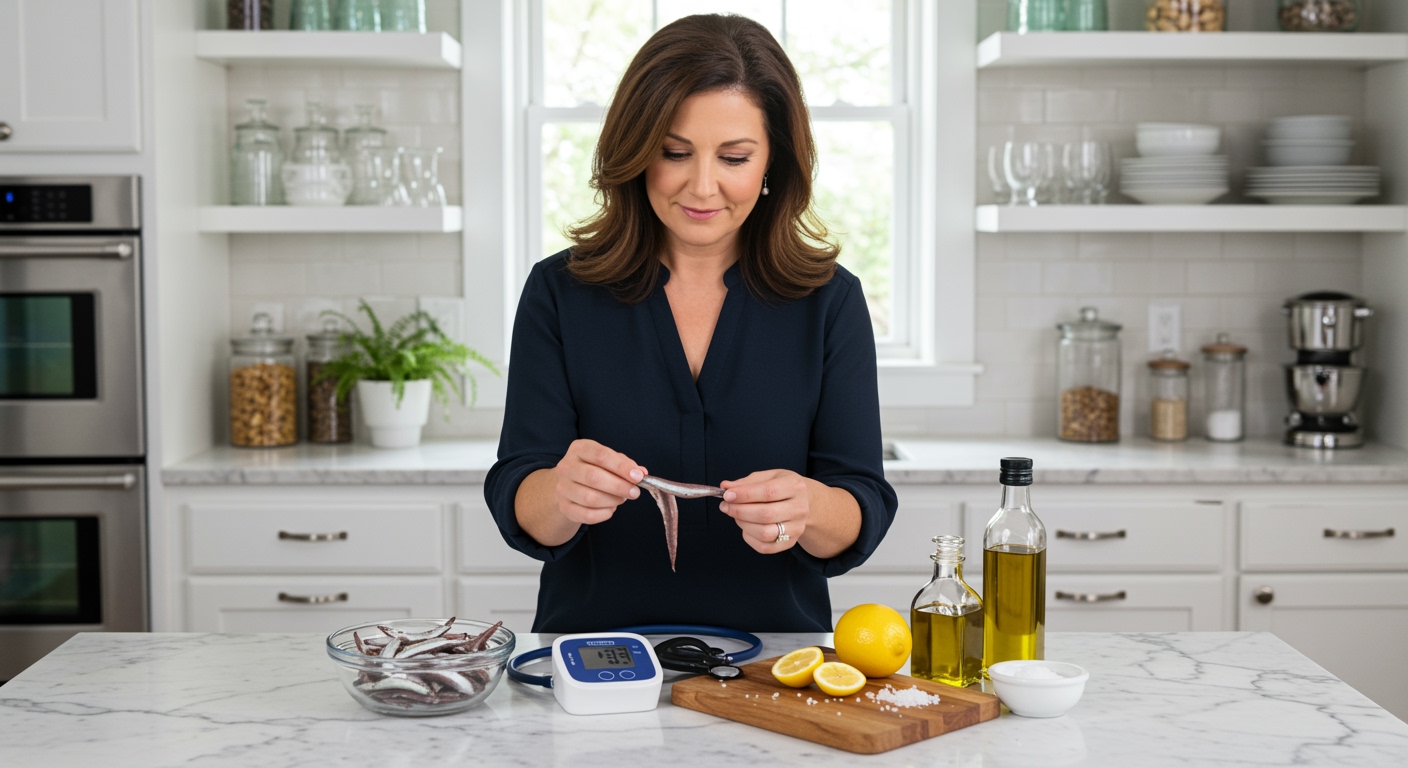✪ Key Takeaway: Sardines typically help lower blood pressure due to omega-3 fatty acids, despite containing sodium.
Introduction
You open a can of sardines and wonder if these tiny fish will send your blood pressure through the roof.
This concern makes perfect sense because sardines contain sodium, and everyone knows sodium raises blood pressure.
Hi, I’m Abdur, your nutrition coach and today I’m going to explain exactly how sardines affect your blood pressure and why the answer might surprise you.
Do Sardines Actually Raise Blood Pressure?
The short answer is no, sardines typically lower blood pressure rather than raise it.
Research shows that people who eat sardines regularly have better cardiovascular health and lower blood pressure readings.
A study published in the Clinical Nutrition journal found that consuming sardines twice weekly for six months significantly reduced systolic blood pressure in adults.
The magic happens because sardines contain powerful omega-3 fatty acids called EPA and DHA.
These omega-3s work inside your blood vessels to reduce inflammation and help your arteries stay flexible.
When your arteries remain flexible, your heart does not need to work as hard to pump blood through your body.
✪ Fact: One can of sardines provides more omega-3s than most people get in an entire week.
What About The Sodium Content In Sardines?
Yes, sardines contain sodium, but the amount varies dramatically depending on how they are processed and packaged.
Fresh sardines contain only about 90 milligrams of sodium per 100 grams, which is quite low compared to most processed foods.
Canned sardines in water typically contain 300-400 milligrams of sodium per 100 grams.
Sardines packed in salt or brine can contain up to 600 milligrams of sodium per 100 grams.
The key is choosing the right type and rinsing them before eating.
When you rinse canned sardines under cold water for 30 seconds, you remove about 40 percent of the added sodium.
Even with the sodium content, the beneficial effects of omega-3 fatty acids typically outweigh the negative effects of moderate sodium intake.
✪ Pro Tip: Choose sardines packed in water or olive oil instead of brine to minimize sodium intake.
How Do Omega-3s In Sardines Lower Blood Pressure?
Omega-3 fatty acids work through several biological mechanisms to reduce blood pressure.
First, they help your blood vessels produce more nitric oxide, a molecule that signals your arteries to relax and widen.
When your arteries are wider, blood flows more easily and your blood pressure naturally decreases.
Second, omega-3s reduce inflammation in your blood vessel walls.
Chronic inflammation makes your arteries stiff and narrow, which forces your heart to pump harder.
Third, these healthy fats help regulate your nervous system and reduce the release of stress hormones that can spike blood pressure.
The EPA and DHA in sardines are the same omega-3s found in expensive fish oil supplements, but sardines provide them in their natural form along with other beneficial nutrients.
✪ Note: Your body absorbs omega-3s from whole fish more effectively than from supplements.
Who Should Be Careful With Sardines?
Most people can safely enjoy sardines as part of a heart-healthy diet.
However, people with severe kidney disease should limit sardines because their kidneys cannot effectively process excess sodium.
If you take blood pressure medications, sardines can actually enhance their effectiveness.
Some people worry about mercury in sardines, but these small fish are actually very low in mercury compared to larger fish like tuna.
Sardines also contain purines, which break down into uric acid in your body.
People with gout should eat sardines in moderation because high uric acid levels can trigger gout attacks.
For everyone else, eating sardines 2-3 times per week provides excellent cardiovascular benefits without significant risks.
✪ Pro Tip: Start with one serving per week and gradually increase to assess your individual tolerance.
How Many Sardines Should You Eat For Blood Pressure Benefits?
Research suggests eating about 100 grams of sardines twice per week provides optimal cardiovascular benefits.
This equals roughly one small can or 4-5 whole fresh sardines per serving.
You should start seeing blood pressure improvements within 4-6 weeks of regular sardine consumption.
The timing of when you eat sardines does not matter much, but eating them with other heart-healthy foods amplifies the benefits.
Try adding sardines to salads with leafy greens, tomatoes, and olive oil for a Mediterranean-style meal.
You can also mash sardines with avocado and lemon juice for a nutrient-dense spread on whole grain toast.
Remember that sardines work best as part of an overall healthy eating pattern that includes plenty of vegetables, fruits, and whole grains while limiting processed foods.
✪ Fact: Combining sardines with potassium-rich foods like bananas enhances their blood pressure lowering effects.
The Bottom Line
Sardines help lower blood pressure rather than raise it, thanks to their high omega-3 content that outweighs their moderate sodium levels.
Small fish can make a big difference in your heart health when you choose them wisely and eat them regularly.
I would love to hear about your experience with sardines or any questions you have about managing blood pressure naturally in the comments below.
References
At NutritionCrown, we use quality and credible sources to ensure our content is accurate and trustworthy. Below are the sources referenced in creating this article:
- PubMed: Sardines and Blood Pressure Research
- University of Barcelona: Health Benefits of Sardines Study
- PMC: Fish Consumption and Cardiovascular Health
- British Heart Foundation: Fish Oils and Blood Pressure Research





